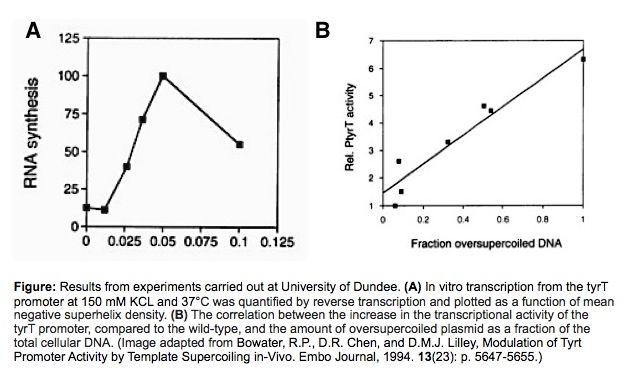Team:UCL London/Research/Supercoilometer/Theory
From 2011.igem.org
Theory of Measuring Supercoils
Transcription from certain promoter sequences have already been indicated to be regulated by the level of supercoiling in the DNA molecule [1]. In fact, the topological state of DNA molecules is one of the regulation mechanism for the rate of transcription of particular genes, especially the ones for tRNAs. This type of transcriptional regulation is referred to as the relaxation-stimulated transcription (RST) response and has also been observed in the case of the promoter for the gyrase enzyme, the only topoisomerase which relaxes DNA molecules by introducing negative supercoils [2]. This response therefore acts as an auto-regulatory mechanism for maintaining a constant level of gyrase enzyme inside the cell and thus also maintain a steady-state topology of the DNA molecules itself.
So far several bacterial promoter sequences have been identified and their supercoiling sensitivity have been studied both in vitro and in vivo using a collection of mutations in order to identify the key sequence crucial for this unique sensory function. Sequence analysis of all of these promoter sequences have revealed a conserved GC rich region between the Pribnow box and the transcription start site, referred to as the ‘discriminator’ region which is now known to be responsible for the supercoiling sensitivity of these promoters. This ‘discriminator’ region is the portion of the promoter sequence which requires melting (strand separation) by RNA polymerase in order to form the pre-initiation complex (PIC) prior to transcription commencement. However GC base pairing involves 3 hydrogen bonds and therefore is much stronger and thus makes the process of PIC formation energetically unfavourable [3]. Consequentially, any factors that facilitate the separation of these strands in the discriminator region, such as the introduction of negative supercoils or low salt concentration, would therefore speed up the rate of transcription initiation from these promoters.
The first promoter to be studied in this area was tyrT (tyrosine tRNA) promoter from Escherichia coli. The initial studies using circular plasmid indicated that this promoter only retained its supercoiling dependence in vitro and not in vivo [4]. However, the lack of RST response in vivo was later explained by the incidence of super-helical diffusion in the DNA molecule, whereby the accumulation of negative supercoils dispersed along the length of the molecule [5]. Insulating the topological state in this discriminator region later restored the function in vivo. Other identified promoter sequences include hisR promoter and leu-500 from Salmonella typhimurium [6]. The supercoiling-sensitivity of the leu-500 have also been successfully tested in vivo in a chromosomal context as compared to all the plasmid studies so far [7]. Therefore, based on all this information we hypothesised that ligating a fluorescent protein expression cassette downstream of the cloned E. coli tyrT promoter on a circular plasmid, will yield a sensory device for measuring the level of negative supercoiling introduced by gyrase into the plasmid DNA molecule.
 "
"
